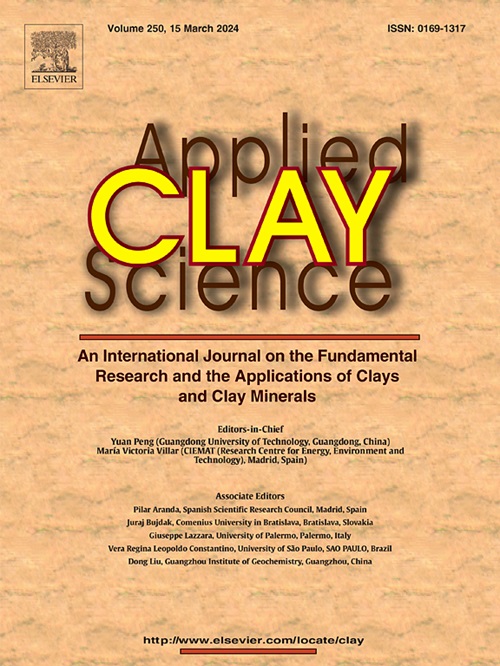Compressibility of a binary bentonite-based mixture with particular emphasis on pellet orientation
IF 5.3
2区 地球科学
Q2 CHEMISTRY, PHYSICAL
引用次数: 0
Abstract
Binary mixtures of Wyoming-type bentonite, consisting of 80 % mass high-density pellets and 20 % granular bentonite, are currently considered candidate materials for the French concept of vertical sealing systems for deep and long-term disposal of radioactive wastes. At low emplacement water contents, the hydro-mechanical behaviour is primarily controlled by contact forces between pellets, forming a coarse grain-supported structure over which granular bentonite is poured. These pellets were uniaxially compacted at elevated stresses to reach high dry densities. Subsequent pellet unloading resulted in anisotropic features due to fissuring and delamination, followed by water absorption. This study investigated compressibility changes upon loading under laterally confined conditions of a well-oriented pellet-supported structure, mimicking the setup of the in situ VSEAL 1 experiment at Tournemire (France). Two pellet orientations at the same dry density and coordination number of pellet contacts were examined in a pure pellet skeleton and a mixture to account for potential heterogeneity during pouring. A discrete element method was used to simulate the compression results with pellets represented as a clump with a heterogeneous void ratio distribution due to fissuring. These simulations were instrumental in understanding the important anisotropic deformation properties of pellet-supported structures under two distinct orientations.
二元膨润土基混合物的可压缩性,特别强调球团取向
怀俄明型膨润土的二元混合物由 80%的高密度球团和 20%的颗粒膨润土组成,目前被认为是法国为深层和长期处置放射性废料而设计的垂直密封系统的候选材料。在填充水含量较低的情况下,水力机械性能主要由颗粒之间的接触力控制,形成一个粗颗粒支撑结构,颗粒膨润土被浇注在该结构上。这些球团在较高应力下进行单轴压实,以达到较高的干密度。随后的颗粒卸载会导致各向异性特征,这是由于裂缝和分层造成的,然后是吸水。本研究模仿图尔奈米尔(法国)VSEAL 1 现场实验的设置,对取向良好的颗粒支撑结构在横向约束条件下加载时的可压缩性变化进行了研究。对纯颗粒骨架和混合物中相同干密度和协调颗粒接触数量的两种颗粒取向进行了研究,以考虑浇注过程中潜在的异质性。使用离散元素法模拟了压缩结果,球团表现为一团,由于裂解,空隙率分布不均匀。这些模拟有助于了解颗粒支撑结构在两种不同方向下的重要各向异性变形特性。
本文章由计算机程序翻译,如有差异,请以英文原文为准。
求助全文
约1分钟内获得全文
求助全文
来源期刊

Applied Clay Science
地学-矿物学
CiteScore
10.30
自引率
10.70%
发文量
289
审稿时长
39 days
期刊介绍:
Applied Clay Science aims to be an international journal attracting high quality scientific papers on clays and clay minerals, including research papers, reviews, and technical notes. The journal covers typical subjects of Fundamental and Applied Clay Science such as:
• Synthesis and purification
• Structural, crystallographic and mineralogical properties of clays and clay minerals
• Thermal properties of clays and clay minerals
• Physico-chemical properties including i) surface and interface properties; ii) thermodynamic properties; iii) mechanical properties
• Interaction with water, with polar and apolar molecules
• Colloidal properties and rheology
• Adsorption, Intercalation, Ionic exchange
• Genesis and deposits of clay minerals
• Geology and geochemistry of clays
• Modification of clays and clay minerals properties by thermal and physical treatments
• Modification by chemical treatments with organic and inorganic molecules(organoclays, pillared clays)
• Modification by biological microorganisms. etc...
 求助内容:
求助内容: 应助结果提醒方式:
应助结果提醒方式:


